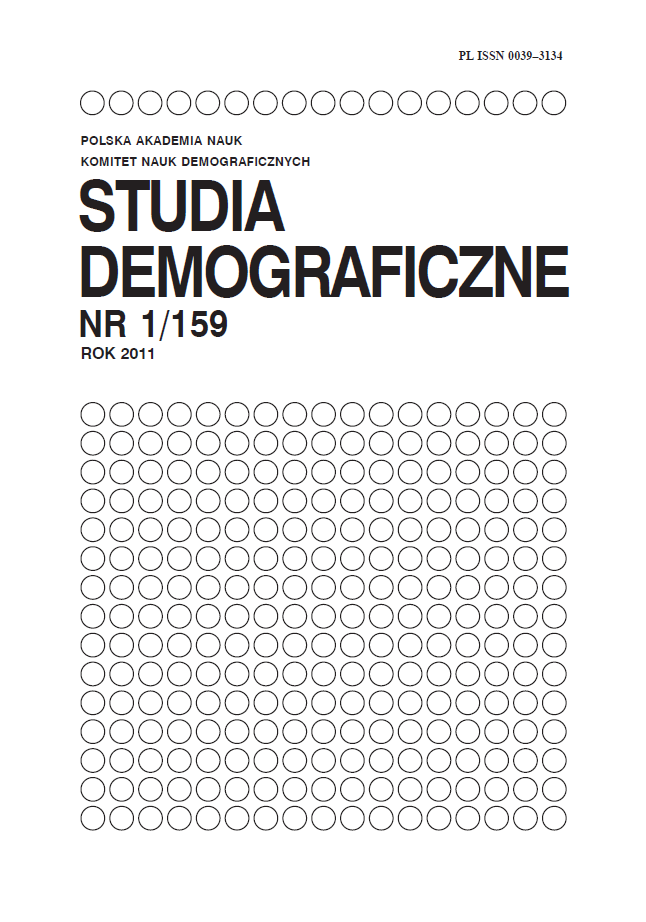O nowych miarach zaawansowania procesu starzenia się ludności
Main Article Content
Abstract
The main aim of the article was to review measures of the population ageing process. In the first part, traditional (conventional) measures of population ageing are presented (i.e. old-age rate, median age, ageing index, dependency ratios, potential support ratio, parent support ratio). These measures are based on chronological age and give a coherent picture of population ageing. However, they do not take into account changes in life expectancy. In other words, they are based on the assumption that a 65-year-old person in 2000 is considered to be just as old as a 65-year-old person in 1900. But the probability of surviving in these two years is different: the remaining life expectancy at age 65 was much higher in 2000 than in 1900.
Therefore, the second part of the article presents the new (alternative) measures of population ageing, which are adjusted to life expectancy. In particular, it describes the following measures: proportion of the population in age groups that have a remaining life expectancy of 15 years or less (Prop. RLE15-), prospective median age, population average remaining years of life, and prospective old-age dependency ratio. In the last section, the results of a comparison between conventional and alternative measures are presented. The new measures indicate a slower pace of population ageing in the future than the traditional ones. Thus, the measures recommended for designing governmental programmes aimed at the elderly are the new measures, which take into account life expectancy.
Article Details
References
[2] Barnay T., Sermet I.C. (red.), 2007, Le vieillissement en Europe. Aspects biologiques, économiques et sociaux, La Documentation Francaise, Paris.
[3] Bourdelais P., 1996, Un seuil évolutif d’âge de la vieillesse: approches comparées France-Suède, „Annales de Démographie Historique”, 85–97.
[4] Calot G., Sardon J.-P., 1999, Les facteurs du vieillissement demographique, „Population”, nr 54(3), 509–552.
[5] Cieślak M., 2004, Pomiar procesu starzenia się ludności, „Studia Demograficzne”, nr 2/146, 3–16.
[6] Kot S.M., Kurkiewicz J., 2004, The new measures of the population ageing, „Studia Demograficzne”, nr 2/146, 17–29.
[7] Holzer J.Z., 2003, Demografia, Polskie Wydawnictwo Ekonomiczne, Warszawa.
[8] Légaré J., 2006, Economic, social, and cultural consequences of the aging of the population, [w]: Casselli G., Vallin J., Wunsch G. (red.), Demography: analysis and synthesis: a treatise in population studies, Elsevier, Amsterdam, 327–336.
[9] Lutz W., Sanderson W., Scherbov S., 2008, The coming acceleration of global population ageing, „Nature”, nr 412, 543–545.
[10] Maksimowicz A., 1990, Przemiany struktury ludności według wieku, [w]: Okólski M. (red.), Teoria przejścia demograficznego, Państwowe Wydawnictwo Ekonomiczne, Warszawa, 266–289.
[11] Mamolo M., Scherbov S., 2009, Population Projections for Forty-Four European Countries: The Ongoing Population Ageing, „European Demographic Research Papers 2”, Vienna Institute of Demography of the Austrian Academy of Science.
[12] ONZ, 2005, World Population Prospects: The 2004 Revision, UN Department of Economic and Social Affairs Population Division, New York.
[13] ONZ, 2009, World Population Prospects: The 2008 Revision, UN Department of Economic and Social Affairs Population Division, New York.
[14] Pison G., 2009, Le vieillissement démographique sera plus rapide au Sud qu’au Nord, „Population & Sociétés”, nr 457.
[15] Rosset E., 1959, Proces starzenia się ludności. Studium demograficzne, Polskie Wydawnictwa Gospodarcze, Warszawa.
[16] Rosset E., 1967, Ludzie starzy. Studium demograficzne, Polskie Wydawnictwo Ekonomiczne, Warszawa.
[17] Rosset E., 1971, Człowiek stary a społeczeństwo, „Studia Demograficzne”, nr 25.
[18] Sanderson W., Scherbov S., 2005, Average remaining lifetimes can increase as human populations age, „Nature”, nr 435, 811–813.
[19] Sanderson W., Scherbov S., 2007, A new perspective on population ageing, „Demographic Research”, nr 16(2), 27–58.
[20] Sanderson W., Scherbov S., 2008, Rethinking age and ageing, „Population Bulletin”, nr 63(4).
[21] Sanderson W., Scherbov S., 2010, Remeasuring aging, „Science”, nr 329(5997), 1287–1288.
